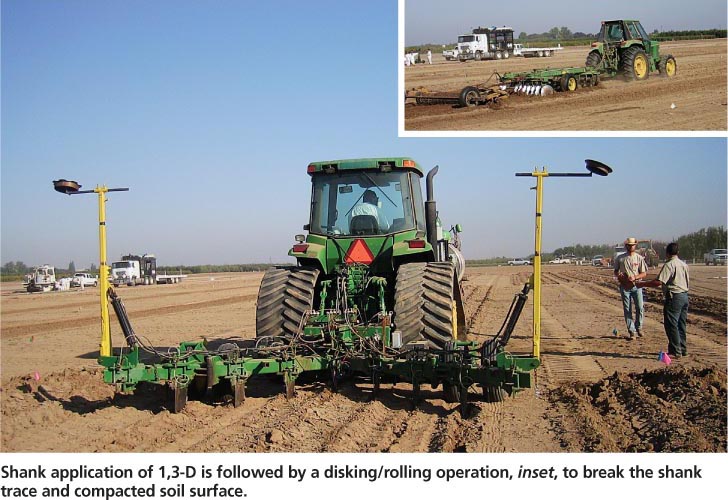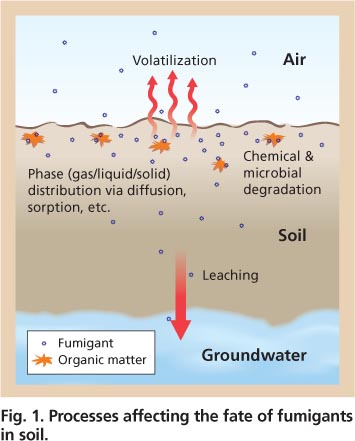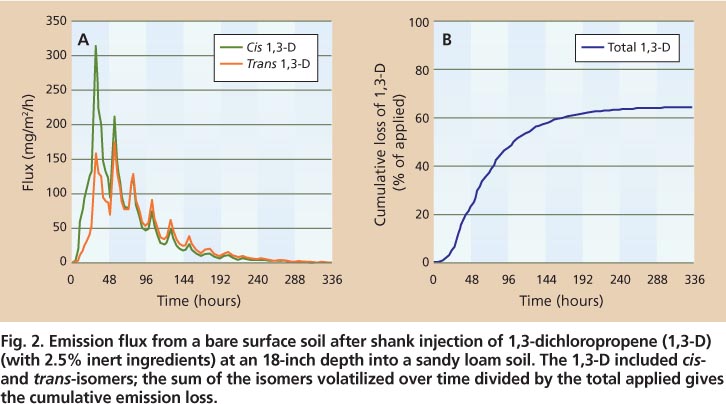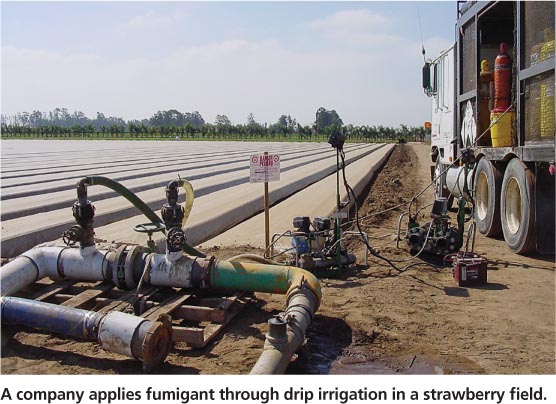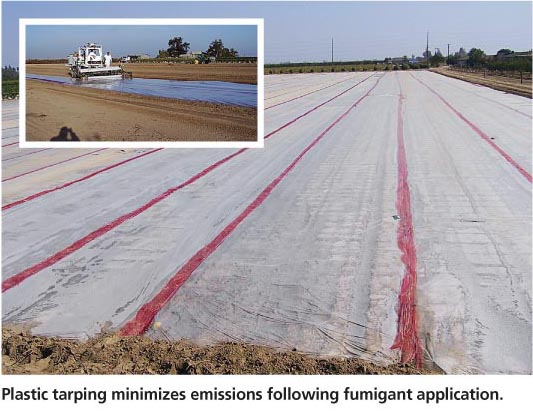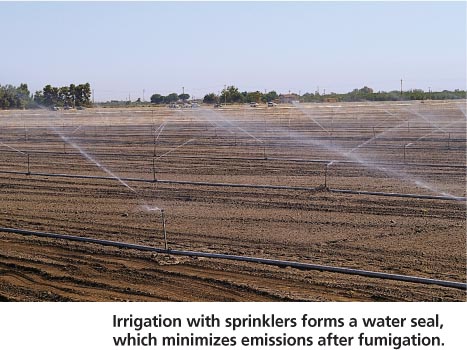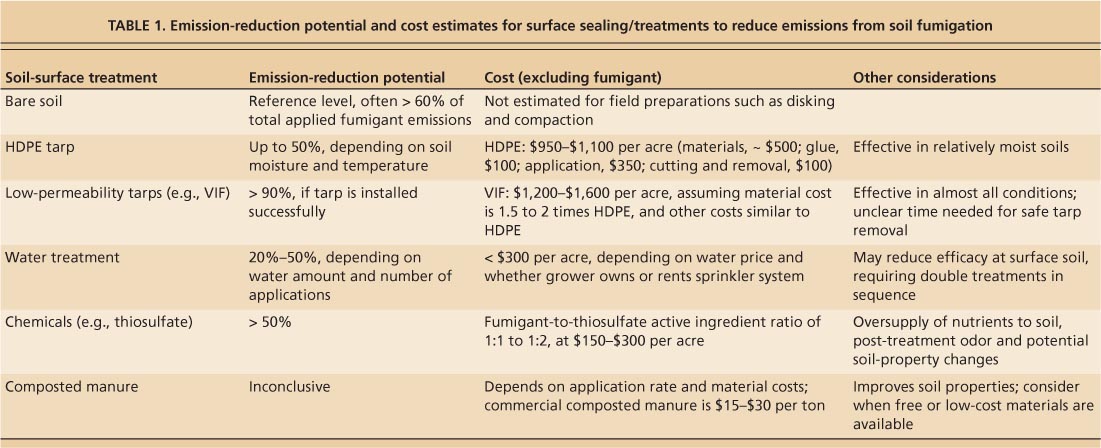All Issues
Methods evaluated to minimize emissions from preplant soil fumigation
Publication Information
California Agriculture 65(1):41-46. https://doi.org/10.3733/ca.v065n01p41
Published January 01, 2011
PDF | Citation | Permissions
Abstract
Many commodities depend on preplant soil fumigation for pest control to achieve healthy crops and profitable yields. Under California regulations, minimizing emissions is essential to maintain the practical use of soil fumigants, and more stringent regulations are likely in the future. The phase-out of methyl bromide as a broad-spectrum soil fumigant has created formidable challenges. Most alternatives registered today are regulated as volatile organic compounds because of their toxicity and mobile nature. We review research on methods for minimizing emissions from soil fumigation, including the effectiveness of their emission reductions, impacts on pest control and cost. Low-permeability plastic mulches are highly effective but are generally affordable only in high-value cash crops such as strawberry. Crops with low profit margins such as stone-fruit orchards may require lower-cost methods such as water treatment or target-area fumigation.
Full text
Soil fumigation with methyl bromide has been used for decades in California to control a variety of soil-borne agricultural pests, such as nematodes, diseases and weeds. Major, high-value cash crops that rely on soil fumigation include strawberries; some vegetables such as carrot, pepper and tomato; and nurseries and orchards for stone fruit, ornamentals and grapevines. In California, tree and grapevine field nurseries must meet requirements of the California Department of Food and Agriculture (CDFA) Nursery Nematode Control Program (CDFA 2008). Without fumigants, the productivity of these cropping systems would suffer from yield losses due to diseases, replant disorders or lack of phytosanitary certification.
Shank application of 1, 3-D is followed by a disking/rolling operation, inset, to break the shank trace and compacted soil surface.
Because of its role in depleting stratospheric ozone, methyl bromide was phased out in the United States and other developed countries as of January 2005, under provisions of the U. S. Clean Air Act and the Montreal Protocol (an international agreement). Some limited uses of methyl bromide are permitted under critical-use exemptions and quarantine/preshipment criteria, which are subject to application and approval annually.
Limited to a few registered compounds, growers have turned to alternative fumigants such as 1,3-dichloropropene (Telone or 1,3-D), chloropicrin (CP) and methyl isothiocyanate (MITC) generators (metam sodium or dazomet) (Trout 2006). In addition to direct toxicity, most of these alternative fumigants are also regulated as volatile organic compounds (VOCs). Some VOCs released into the atmosphere can react with nitrogen oxides under sunlight to form harmful ground-level ozone, an important air pollutant.
Regulations such as use limits and buffer zones have been used to minimize emissions and protect public and environmental health. More-stringent regulations are being developed for fumigants to reduce air emissions, especially in ozone-nonattainment areas such as Ventura County and the San Joaquin Valley (CDPR 2008; Segawa 2008).
The UC Statewide Integrated Pest Management Program recently prepared a field fumigation guide for emission control, which is available on the California Department of Pesticide Regulation website (UC IPM 2009). This paper is not intended to represent or serve as a replacement for that guide, but rather to update findings on emission-reduction technologies, including projects under the U. S. Department of Agriculture Agricultural Research Service (USDA-ARS) Pacific Area-Wide Pest Management Program. We summarize extensive research on emission reduction from soil fumigation conducted over the last few years, and identify agricultural practices for minimizing fumigant emissions while achieving good efficacy. We also identify knowledge gaps and other research needs for the near future.
Factors affecting emissions
Soil fumigants are volatile chemical compounds. The purpose of fumigation is to achieve maximum control of soilborne pests, which requires an effective concentration or exposure duration and the uniform distribution of fumigants in soil. A number of processes affect the fate of fumigants after soil application (fig. 1). Fumigants are subject to partitioning into soil air, water and solid phases (most importantly, organic matter); volatilization (emission); degradation (chemical and microbial), movement in soil via diffusion; and potential leaching. Volatilization and leaching can potentially contaminate the air and water. Emission loss is a major airquality concern. To minimize emissions as well as ensure efficacy, it is necessary to contain fumigants in the rhizosphere where plant roots are present and soilborne pests are dominant. Without proper containment, more than half of fumigants applied can be lost through emissions (fig. 2).
Soil conditions (such as texture, moisture and organic matter content), weather and surface barriers, and the chemical properties of the fumigant can all affect emissions. Generally speaking, lower emissions are expected from soils with fine texture, high water content, high organic-matter content and low temperature compared to dry soils with coarse texture, low organic-matter content and high temperature. Approaches to reducing fumigant emissions include application methods such as equipment design (injection depth), physical barriers, irrigation, soil amendment with chemicals or organic materials and target-area treatment.
Fig. 2. Emission flux from a bare surface soil after shank injection of 1, 3-dichloropropene (1, 3-D) (with 2. 5% inert ingredients) at an 18-inch depth into a sandy loam soil. The 1, 3-D included cis-and trans-isomers; the sum of the isomers volatilized over time divided by the total applied gives the cumulative emission loss.
Current application techniques include broadcast fumigation and chemigation. With standard broadcast fumigation, fumigants are applied directly to the soil at a certain depth using conventional equipment or rigs (shanks). Chemigation is injecting fumigants into soil with irrigation water through sprinklers or drip tapes.
Applying fumigant deeper in the soil lowers emissions by increasing fumigant travel time to the surface and its interaction with soil. Increasing the shank-injection depth from 12 to 24 inches (30 to 60 centimeters) resulted in a 20% or greater reduction of methyl bromide emissions in bare soils (Yates et al. 2002).
The general consensus for bare-soil fumigation is that emissions from drip application, especially subsurface, are lower than broadcast-shank injections (Gao, Trout, Schneider 2008; Wang et al. 2009). This is attributable to two factors: (1) increasing soil water content decreases air pore volume (i. e., vapor diffusion) and increases the amount of fumigant partitioning in the aqueous phase and (2) there are no shank traces (i. e., soil fractures) that can serve as volatilization channels. The fumigant diffusion rate in the liquid phase is much slower than in the gas phase. Substantially higher soil water content would reduce the fumigant's distribution in soils by reducing vapor diffusion, reducing efficacy. Good efficacy can only be ensured when the fumigant moves with applied water for a relatively uniform distribution (Ajwa and Trout 2004). However, because fumigants are highly volatile, drip-applied fumigants near soil surfaces without any barriers may still result in high emission losses. Currently, about half of California's strawberry acreage, especially in the coastal areas, is fumigated using drip application.
Plastic films
Plastic tarping or “mulching” is the most commonly used practice to contain fumigants in soil and control emissions. The effectiveness of tarping on emission reduction depends largely on the chemical's characteristics and tarp permeability, and also to some extent on soil conditions. Tarping with polyethylene film was found to be ineffective to control 1,3-D emissions, especially in relatively dry soils (Gao and Trout 2007; Papiernik and Yates 2002). However, high-density polyethylene (HDPE) tarp applied over irrigated soil can substantially lower 1,3-D emissions, due to both higher soil water content and water condensation under the film (Gao and Trout 2007). About 50% emission reduction was measured for an HDPE-tarped treatment in relatively cooler fall weather conditions, compared to bare soil (Gao, Hanson, et al. 2009). Tarped treatment in pre-irrigated soil in summer may also improve pest control due to elevated soil temperatures under the tarp. Shrestha et al. (2006) observed significant reductions in weed populations due to high temperatures up to 117°F under the tarp, which was partially attributed to the effect of solarization.
Virtually impermeable film.
Low-permeability films, including virtually impermeable film (VIF), showed great potential in early laboratory or smallplot tests (Wang et al. 1997b). VIF has much lower permeability to most fumigants than HDPE films (Ajwa 2008).
VIF is generally a multilayered film composed of barrier polymers such as nylon or ethyl vinyl alcohol (EVOH) sandwiched between polyethylene polymer layers (Villahoz et al. 2008). A number of studies have shown that VIF can retain higher fumigant concentrations than HDPE film, reducing emissions while improving efficacy, especially for weed control (Hanson et al. 2008; Noling 2002). The effectiveness of VIF in large-field applications has been difficult to ascertain because it can be damaged during field installation, with potential changes in permeability.
Recent field data confirmed that this type of film can effectively reduce emissions more than 90% (Ajwa 2008; Gao, Qin, et al. 2009). The tarp permeability did increase after field installation but was still substantially lower than that of polyethylene films (Qin, Gao, Ajwa 2008; Yates 2008). There are also concerns about damage from field installation and improper gluing materials in the VIF tarp. These potential problems, however, were not observed in a recent field trial (Gao, Hanson, et al. 2009), when a Bromostop VIF (0.025-millimeter thickness) from Bruno Rimini Corp. (London, U. K.) was applied to a shank-injected 1,3-D (Telone II) field, achieving greater than 95% emission reduction.
Totally impermeable film.
A new type of low-permeability film, so-called totally impermeable film (TIF), was reportedly easier to install and maintain in field applications (Chow 2008; Villahoz et al. 2008). This film has even lower permeability to fumigants than some other VIFs (Ajwa 2008). For example, the mass-transfer coefficient (indicating tarp permeability to fumigants) for TIF was 0.0004 inch (0.001 centimeter) per hour for cis 1,3-D compared to 0.028 inch (0.07 centimeter) per hour for Bromostop VIF before field application, and 0.008 inch (0.02 centimeter) versus 0.106 inch (0.27 centimeter) per hour, respectively, after installation over raised beds in the field.
TIF is a five-layer film incorporated with a middle layer of EVOH into a standard polyethylene-based film (Chow 2008). Information on field emission reductions is insufficient because this film has not been made available commercially. The most recently reported research data indicated that TIF can have similar effectiveness in reducing emissions as other VIFs; but these low-permeability films can cause emission surges when the tarp is cut and after about 1 week, due to the release of high amounts of retained fumigant (Gao et al. 2010). These emission surges would increase exposure risks to workers and bystanders. To reduce the risk, the waiting period between fumigation and tarp cutting or removal should be long enough for fumigants to degrade under the tarp. VIFs can retain fumigants under the tarp, making lower application rates possible, provided that satisfactory pest control can be achieved. The low-permeability films also showed the potential to improve the uniformity of fumigant distribution up to a certain depth in the soil profile, so lower application rates than are currently used for bare soil or underneath standard polyethylene film would be possible.
Water seals and pre-irrigation
With proper management, postfumigation water seals (with sprinklers) and pre-irrigation can reduce emissions to some extent. The latter is used to achieve adequate soil moisture if the soil is dry, but not to a level that would inhibit fumigant movement/distribution in the soil profile. Water seals reduce fumigant emissions by forming a high-water-content layer at the soil surface, which serves as a barrier preventing the fumigant from diffusing into the air (Wang et al. 1997a).
Some earlier studies showed that high water content in the surface soil provided a more effective barrier to 1,3-D movement than HDPE tarping (Gan, Yates, Wang, et al. 1998). Intermittent water seals following soil fumigation have been effective in reducing emissions of methyl isothiocyanate (Sullivan et al. 2004; Wang et al. 2005) and 1,3-D or chloropicrin in the field (Gao and Trout 2007; Yates et al. 2008a). The effect is more pronounced in reducing emission peak flux, or volatilization rates from soil, by as much as 80% following fumigant application (Gao, Qin, et al. 2009). When irrigation stops, however, the emission flux tends to increase, depending on fumigant concentrations in the soil. As a result, cumulative or total emission losses may not be reduced as substantially as the peak flux. Reducing the peak flux is important because it lowers the potential exposure risk to workers and bystanders. Buffer zones are determined based on the peak emission flux.
When the proper amount of water is applied, water seals do not necessarily reduce fumigant concentration and distribution in the soil profile. This would hold true when only a relatively wet surface layer (up to 6 inches of soil) is maintained, and this layer should help retain fumigants in the soil. More frequent water applications appear to be more efficient in reducing emissions than fewer applications with large amounts of water. But the high water content in surface soil can reduce the efficacy of a fumigant to control nematodes and weeds at or near the soil surface (Hanson et al. 2008). Sequential treatment should be considered when surface pest control is a concern.
Chemical treatments
Soil amendments with chemicals (such as ammonium or potassium thiosulfate [ATS or KTS], thiourea or polysulfides) sprayed over surface soil are extremely effective in reducing emissions. These chemicals can react with fumigants such as methyl bromide, 1,3-D, chloropicrin and iodomethane (methyl iodide) to form nonvolatile compounds by dehalogenation (Gan, Yates, Becker, et al. 1998; Wang et al. 2000). The practicality of using these chemicals on a large field scale to reduce fumigant emissions has yet to be determined. Considerations include cost factors when large quantities of thiosulfate are needed, and potentially undesirable soil-fumigant-thiosulfate reactions.
Field trials involving spraying KTS on the soil surface following fumigation revealed that this chemical can significantly reduce emissions of 1,3-D (by about 50%) and chloropicrin (by 85%) (Gao, Qin, et al. 2008). By destroying fumigant, this chemical treatment would potentially reduce the fumigant dosage at or near the soil surface, but studies showed either no effect or a limited impact on its efficacy for controlling nematodes and/or weeds (Gan et al. 2000; Gan, Yates, Becker, et al. 1998). However, strong reactions between KTS and the fumigant occurred, which resulted in a reddish-brown surface soil color and an unpleasant smell that lasted for several weeks. This reaction was not observed in a strawberry field when KTS was applied to the furrows of raised beds, most likely due to the low levels of fumigant emission measured from the furrows (Qin, Gao, Ajwa 2008; Qin, Gao, McDonald, et al. 2008). Zheng et al. (2007) indicated that the smell may have been derived from sulfur byproducts of the transformation of thios-ulfate and fumigants in the soil.
Amendments and target treatments
Soil amendment with organic materials such as composted manure has been effective in degrading fumigants and also reducing emissions in the laboratory and some field studies. Because fumigants are readily incorporated into organic matter (Xu et al. 2003), soil with high organic-matter content was reported to produce lower emissions (Ashworth and Yates 2007). However, field data is inconclusive regarding the efficacy of adding organic amendments such as composted dairy manure right before fumigation to reduce fumigant emissions.
Yates et al. (2008b) reported that a field with organic matter (composted municipal green waste) incorporated in the previous year resulted in much lower emissions than a field without the amendment but with water seals. In a field trial with relatively high fumigant application rates, manure incorporation at 5 and 10 tons per acre (12.4 and 24.7 megagrams per hectare) did not reduce emissions (Gao, Qin, et al. 2009). Similarly, a recent trial using a higher amendment rate of 20 tons per acre (49.4 megagrams per hectare) also did not show emission reduction, possibly due to reduced bulk density from too much organic material (Gao, Hanson, et al. 2009). The quantity and quality of organic matter may also determine its effectiveness in reducing emissions. High manure application rates accompanied by irrigation and/or strong surface compaction may be needed to achieve emission reduction. However, increasing the incorporation rate may be too costly to be worthwhile.
The fumigation of targeted areas such as tree rows or tree sites may be applicable for orchards where replant disease is a major concern (Browne 2008). The shank application of fumigants in row-strip (shank-strip) or drip application of fumigant in tree sites (drip-spot) have been tested in fields for efficacy as well as emissions (Gao, Trout, Schneider 2008; Wang et al. 2009). These target-area treatments lower emissions by reducing the treated acreage to less than 50% (shank-strip) or 10% (drip-spot), automatically reducing the total amount of fumigants applied. Applying surface sealing or water treatment can achieve further emission reduction.
Cost estimates
Cost is important when evaluating the feasibility of emission-reduction techniques for different commodities (table 1). Field data from a number of trials showed that low-permeability plastic tarps are the most promising technique but also the most costly. The commonly used standard polyethylene tarp costs about $950 to $1,100 per acre depending on acreage, with higher costs for small acreage and lower costs for large acreage (personal communication, industry representatives). Costly plastic materials may not be affordable for commodities with low profit margins, such as stone fruit orchards and annual vegetables.
Low-permeability films such as VIF or TIF generally cost 1.5 to 2 times the cost of polyethylene films. In addition to the higher cost for VIF, high levels of fumigants may be released into the atmosphere upon removal or when planting holes are cut into the tarp. To reduce potential exposure risks, longer waiting periods between fumigation and tarp cutting/removal are necessary to allow fumigant degradation in soils. This issue requires further detailed investigation, as the fate of fumigants would vary depending on the soil and environmental conditions. If applicable, the injection of thios-ulfate through drip irrigation under the tarp may effectively reduce this risk (Qin et al. 2007), although no field tests have been done.
Caution must be taken when considering a chemical treatment such as thiosulfate for reducing emissions. The cost of this chemical fertilizer is low, at less than $2 per gallon (about 11 pounds) of ammonium thios-ulfate (Thio-Sul, containing 12% nitrogen and 26% sulfur). To meet crop sulfur requirements, ammonium thiosulfate is recommended at 6 to 12 gallons per acre for row and vegetable crops, and 5 to 10 gallons per acre for trees and vines using soil injection and surface banding, or 15 to 20 gallons per acre in a broadcast spray ( www.tkinet.com/thiosul.html ). However, fumigation rates are often much higher than fertilization rates. For example, 1,3-D can be applied at a maximum rate of 33.7 gallons (332 pounds active ingredient) per acre in California. Research showed that to significantly reduce emissions, thiosulfate and fumigant are needed at a ratio greater than one-to-one in molecular weight. For 1,3-D, a one-to-one ratio would require about 75 gallons of ammonium thiosulfate containing the active ingredient, at a cost of about $150 per acre. While this level of thiosulfate would likely reduce emissions, it could also introduce excessive nutrients or salts that cause other serious crop-production concerns. Thus, large-field applications of chemical treatment with thiosulfate are undesirable. Additional concerns with chemical treatment are the post-application odor and potential soil-property changes that have not been fully addressed.
TABLE 1. Emission-reduction potential and cost estimates for surface sealing/treatments to reduce emissions from soil fumigation
Water seals, deep injection, drip application and the incorporation of high rates of organic materials are also low-cost options to control fumigant emissions. Using water costs much less than plastic tarps and offers some environmental benefits, because no materials must be disposed of. The cost for a 25-millimeter water application by sprinklers ranges from $100 to $300 per acre, depending on whether the grower owns or rents the sprinkler system. The overall cost of using water is currently substantially lower than plastic tarps, but this may change over time depending on water supplies in California.
Commercially available, clean, composted manure costs $15 to $30 per ton. The costs to apply higher rates than 25 tons per acre may not be feasible for commodities with low profit margins. In some situations, composted green waste from municipalities may be available at no cost; however, this material may also contain other undesirable waste products, such as plastic.
Research needs
Reducing emissions from soil fumigation is required to comply with environmental regulations. Low emissions can be achieved through the management of application methods such as deep injection and subsurface drip, physical barriers with plastic films, irrigation to form water seals or achieve relatively moist soil conditions, and the reduction of treatment areas to planting rows or sites. Soil chemical treatment (e. g., thiosulfate) can be effective in lowering emissions and may prove to be an effective strategy for extreme cases, such as fumigant spills. Although the incorporation of composted dairy manure to surface soil at or below 25 tons per acre did not reduce emissions in some field tests, the longer incorporation times and higher rates accompanied by certain soil preparations or more effective materials may have the potential to reduce emissions and improve soil physiochemical properties. Low-permeability plastic tarps such as VIF have shown the most promise in reducing emissions while improving efficacy. This type of film may also need lower application rates, which can help compensate for its high cost.
Research on the performance of the next generation of low-permeability films is needed for large-field applications. Any emission-reduction technology that enhances degradation or reduces fumigant concentration in soil or surface soil would have an undesirable impact on pest control because of the reduction in exposure dosage. This makes it more desirable to use low-permeability tarps, which unfortunately cost the most. Feasible techniques for different commodities depend on their availability to the production system, effectiveness in emission reduction, potential impact on pest control and cost.



